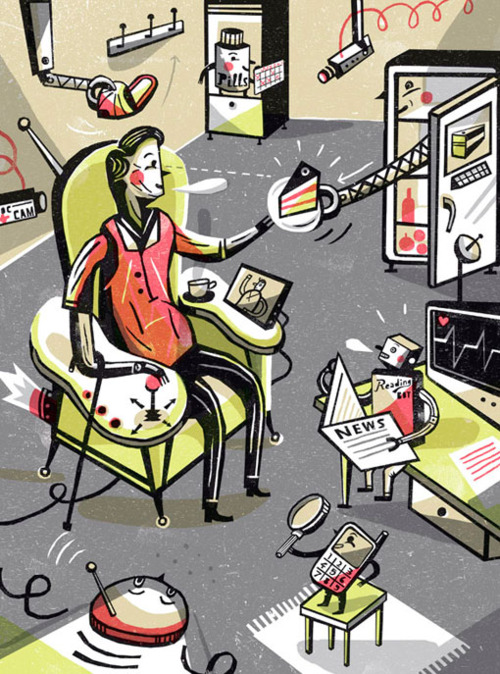Reclaim Your Productivity with Flexible Time Blocks
For many freelancers, the inability to keep some semblance of a regular schedule in the midst of a chaotic existence is a constant source of anxiety and lack of productivity. Insomnia, sudden and frequent interruptions, visiting family, travelling for weddings, and the average sick day (or series of sick days) – all of these occurrences (and many others) can cause the delicate balance of a freelancer’s schedule to careen off course. This can unfortunately result in missing deadlines, losing clients, and other not-so-awesome consequences.
Which is why in today’s post I’m going to show you a method I developed during a prolonged bout of insomnia that has helped me stay on task no matter how random my day becomes. Its all about breaking your ideal work day down into flexible time blocks so that you can rearrange them at a moment’s notice.
A “Normal” Schedule
One of the great things about having a “normal” job where you get up, go to work, and come home at the same time every day is that at a certain point the routine takes over for you. What I mean by that is that as the routine becomes habit you no longer have to think about what you should be doing at any given point in the day. You know: at these times I’m working and at those times I’m resting; then at five o’clock I go home.
If you had a “normal” job, your schedule might look something like this:
- 7am – wake up/shower/eat breakfast
- 9am – work day begins
- 10:30am – break
- 10:45am – back to work
- 12pm – lunch
- 1pm – back to work
- 3pm – break
- 3:15pm – back to work
- 5pm – work day over/go home
The Freelance Lifestyle
It’s easy to be productive when you have an externally imposed schedule, assigned tasks, accountability, and consistency. Sure, after a while that sort of thing can get boring to most people, but if the goal is getting your work done it’s hard to beat a good ol’ fashioned boring schedule like the one above. But honestly freelancers, when is the last time your work day looked anything like the one above? Possibly never.
The more likely scenario is some variation of this:
You wake up roughly 8-10 hours after you went to bed. Grab some coffee and breakfast, play a video game and/or watch tv. Basically the goal at this point is to wait until the idea of being awake doesn’t offend you anymore.
Now it’s time to do some work. But of course, before work can commence you need to check your email and social media sites. This may take a while.
Before long, it’s lunch time. Little to no actual work has been done. After lunch it’s time to get serious; half your day is gone and you’ve barely accomplished anything. You dive into work at a feverish pace. After 3-4 solid hours of work you need a break. You also need to run errands, meet someone for coffee, or in general just be/do something else for a while.
When you get back to your work station you have a choice to make: should you keep working today? After all it’s nearly time for dinner. You could go meet some friends, go shopping, etc.. But of course it depends on your deadlines. If it’s possible to get the work done tomorrow, work is most likely over for today. On the other hand, if it is not possible to get the work done tomorrow, you eat dinner and then work into the night until either your work is finished or you can no longer stay awake.
This sort of lifestyle might sound semi-irresponsible to most, but in all honesty I know a lot of people who get along just fine on a freelance work schedule similar to the one I just outlined. Just like people who follow the “normal” schedule, freelancers with a more “go with the flow” approach tend to find a rhythm that works for them and while it may be a bit unconventional and needlessly stressful at times (due to the procrastination), they’re good at what they do and they get their work done on time. If they didn’t, they wouldn’t be freelancers for long.
No, the real problem is something faced by everyone in the workforce. The only difference being that the isolated freelancer is at a unique disadvantage when it comes to coping with it.
The Randomness of Life
In sports and in war the analogy goes that your plans are only good up until the point that you begin. After that, anything can and will happen, and you have to adapt or die. Or possibly just lose. The point is it’s the same for life in general. No matter how organized or meticulously scheduled your day/week/year is, anything can and will happen, and in the end you just have to do the best you can.
At a normal job there’s a structure and flow to things that is not dependent on you. Which means when life throws you a curve ball and all of your plans go right out the window, there’s a boss, co-worker, or project manager there to help get you back on track. The problem for us freelancers is that because we’re a one-man or one-woman show and we’ve constructed a schedule that works solely for us, our work flow is easily disrupted and painstakingly re-established. A death in the family, a wedding you have to attend, inexplicably going sleepless for a week straight, and the list goes on. Any one of those random life events can derail a good work flow and if they continue to come at a brisk enough pace, it can feel impossible to get yourself back on track.
Making “Random” Work For You
During the course of my own freelance career life has thrown me plenty of curve balls. One particularly challenging “life event” was when I had to deal with what I hope is the worst case of insomnia I will ever have. For months I couldn’t get a good night’s sleep. If I did sleep it was short, fitful, and at a random time of the day.
Most people – I think – go through periods where they have difficulty sleeping. But they tough it up, grab some extra coffee, and their body does it’s thing and adjusts itself back to normal without anything extreme happening. But that didn’t happen for me. I tried everything I could think of and nothing seemed to work. Eventually I realized that if I was going to continue to pay my bills then I would have to figure out a way to sleep when I could get it and work when I wasn’t sleeping – no matter what time of day (or night) it happened to be.
What I came up with was a simple twist on the “normal” schedule above. I made a time-table that encompassed my ideal work day, including sleep and free-time before and after work. Instead of labeling each activity with a specific time of day though, I assigned each activity throughout my day a duration.
- 45 min – workout
- 60 min – coffee and reading
- 60 min – shower/shave/get dressed
- 30 min – breakfast
- 30 min – free write
- 30 min – email and daily planning
- 90 min – creative work
- 30 min – walk/break
- 90 min – creative work
- 60 min – lunch
- 90 min – creative work
- 30 min – nap/break
- 60 min – tasks/errands
- 60 min – free time
- 60 min – free time
- 60 min – free time
- 60 min – free time
- 60 min – sleep
- 60 min – sleep
- 60 min – sleep
- 60 min – sleep
- 60 min – sleep
- 60 min – sleep
- 60 min – sleep
- 60 min – sleep
On an ideal day I would wake up at 5am (I’m a morning person), begin with a workout and move straight through these time blocks. Work would end at 5pm and I would end up in bed between 9pm and 10pm. That would give me a workout, time to feed my brain, a full work day, reasonable resting intervals, and free time to hang out with friends or simply manage the rest of my life. Oh, and a solid seven to eight hours of sleep every night! To me, that is balance.
But when I was suffering from insomnia that lifestyle was impossible. The purpose behind breaking my day down into time blocks was to disassociate specific activities from specific times of the day. This way if I happened to wake up at say, 6 o’clock in the evening after three hours of sleep, I could go grab dinner with some friends, see a movie, spend time with my girlfriend, whatever. I knew that each day contained four hours of free time that I could use whenever I wanted to, regardless of the fact that I would normally spend the first four hours of my day quite differently. After that I would begin to work my way through the other time blocks (including more sleep if possible) using a chart of them (which I kept in a notebook on my desk) to keep me on task.
Without a doubt this method will take some getting used to. It’s surprising how powerful the impulses we train ourselves to have at different times of the day are. If you go to bed at 4pm and wake up at 12am, it feels extremely weird to just work through your day as if you were waking up at 7am or 8am. It doesn’t feel right. But when you stop thinking of your daily activities as “appropriate” for whatever time of day it is and think strictly in terms of time allotted per activity, you can find your way back to a structured schedule no matter how random your life gets.
Final Thoughts
The example I used in the section above is an instance where this method helped me get through a tough time with insomnia. I was able to remain productive (in a disjointed sort of way) until my sleep cycle normalized. But that’s not the only instance in which this method has helped me keep on top of my work schedule. If it were I probably wouldn’t have shared it here; I doubt the majority of Desizn Tech readers suffer from intense insomnia. What I’ve found though is that this method works for just about any instance in which your schedule veers off course and you need to re-group and re-focus.
There are a lot of reasons someone who manages their own work day/schedule might end up feeling lost in the flow and unable to maintain productivity. Even something as simple as staying out late one night and waking up hours later than normal the next day can often lead to wasting valuable time. It just doesn’t feel right because in your head you might wake up and think, “Well, today’s a lost cause.” But you still have the same 24 hours ahead of you! It’s all in how you view them.
(feature image via)



